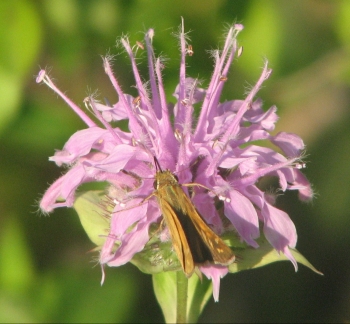Sachem Skipper Butterfly; Atalopedes campestris; Sachem, or better known as Skipper, butterflies are thick bodied butterflies with rather small wings (1.25-1.5″), which seem to flit, or “skip” between flowers in an almost bee-like manner in open areas. Skippers are so hairy, and their even, brown coloring, marked by dull orange, so drab they are sometimes considered moths. Like other moths, they also have short, stiff, spike-like hairs on the legs, useful for deterring predatory birds. More notable are the transparent “windows” in the fore-wings, more or less rectangular patches (2-8, depending on species), which have no color scales. Sachem was named for Algonquin hereditary, consensus leaders, noted for their wisdom and composure, not charisma and war-prowess. Native to South-Eastern, Southern USA and northern Mexico, Skippers lay single eggs on dry grass, where the caterpillars feed on a range of grasses often chosen for lawns, such as St. Augustine, or Bermuda, often making a safe-house for themselves by rolling dry grass and leaves into a protective tube.

Sachem Butterfly; a thick bodied butterfly with rather short, dull grey-brown wings less than 2″ across, common in open areas.
Note; small, transparent to silver “windows” in otherwise drab wings.

Note; adult Sachem feed off the nectar of a wide range of flowers, the larva feeding on low-growing grasses.






